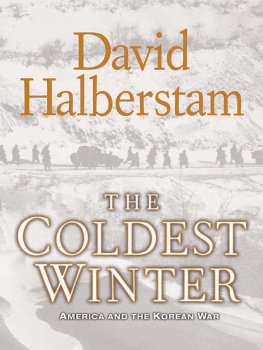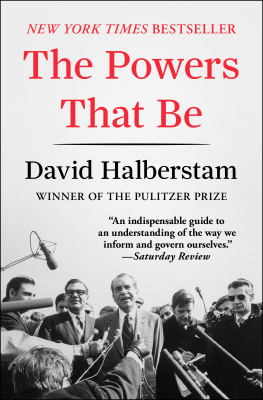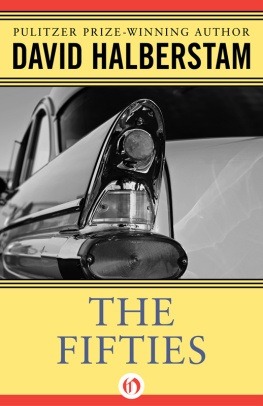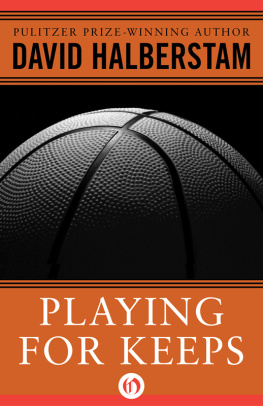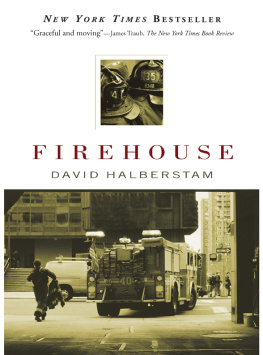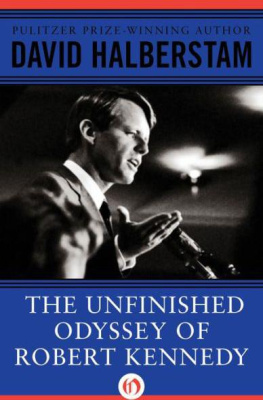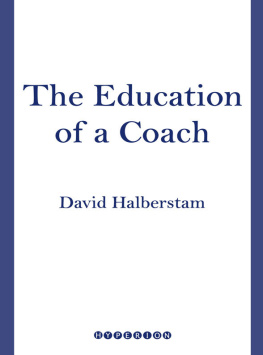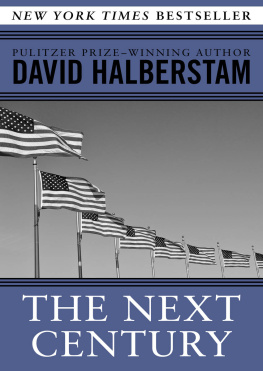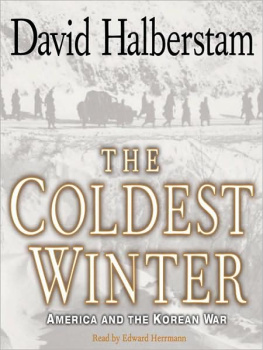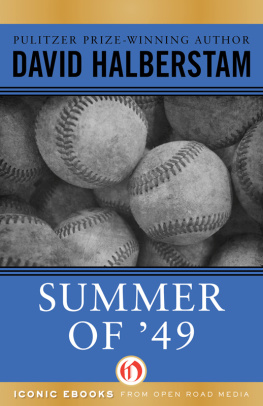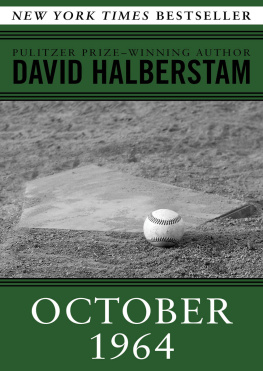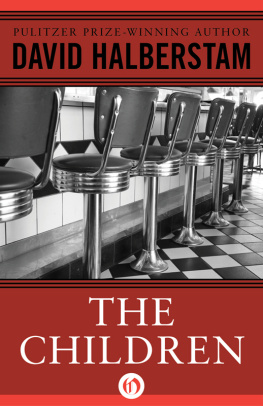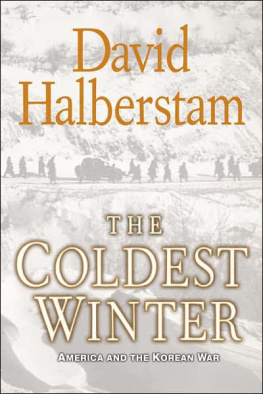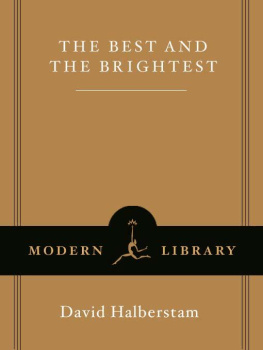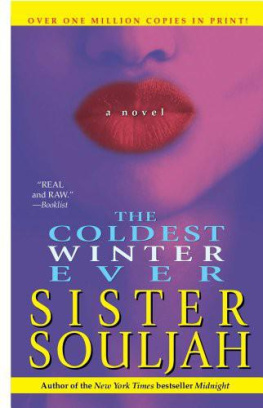David Halberstam - The Coldest Winter
Here you can read online David Halberstam - The Coldest Winter full text of the book (entire story) in english for free. Download pdf and epub, get meaning, cover and reviews about this ebook. publisher: Hachette Books, genre: History. Description of the work, (preface) as well as reviews are available. Best literature library LitArk.com created for fans of good reading and offers a wide selection of genres:
Romance novel
Science fiction
Adventure
Detective
Science
History
Home and family
Prose
Art
Politics
Computer
Non-fiction
Religion
Business
Children
Humor
Choose a favorite category and find really read worthwhile books. Enjoy immersion in the world of imagination, feel the emotions of the characters or learn something new for yourself, make an fascinating discovery.
- Book:The Coldest Winter
- Author:
- Publisher:Hachette Books
- Genre:
- Rating:4 / 5
- Favourites:Add to favourites
- Your mark:
- 80
- 1
- 2
- 3
- 4
- 5
The Coldest Winter: summary, description and annotation
We offer to read an annotation, description, summary or preface (depends on what the author of the book "The Coldest Winter" wrote himself). If you haven't found the necessary information about the book — write in the comments, we will try to find it.
The Coldest Winter — read online for free the complete book (whole text) full work
Below is the text of the book, divided by pages. System saving the place of the last page read, allows you to conveniently read the book "The Coldest Winter" online for free, without having to search again every time where you left off. Put a bookmark, and you can go to the page where you finished reading at any time.
Font size:
Interval:
Bookmark:

America and the Korean War

For Jean, again
N OTE ON M ILITARY U NITS
The size, composition, and leadership of military units varies with time, place, and circumstances. In the early fighting in Korea, almost every unit was always understrength. Therefore, these numbers are approximations.
| Army | 100,000 soldiers |
| Comprised of 2 or more Corps | |
| Normally commanded by a full General | |
| Corps | 30,000 soldiers |
| Comprised of 2 or more Divisions | |
| Normally commanded by Lieutenant General | |
| Division | Up to 15,000 soldiers, often only 12,000 in Korea |
| Comprised of 3 Regiments | |
| Commanded by Major General | |
| Regiment | Up to 4,500 men, with affiliated units, such as artillery, armored, and medical units, included |
| Comprised of 3 Battalions | |
| Commanded by Colonel | |
| Battalion | 700 to 850 soldiers |
| Comprised of 4 or more Companies | |
| Commanded by Lieutenant Colonel | |
| Company | 175 to 240 soldiers |
| Comprised of 4 Platoons | |
| Commanded by Captain | |
| Platoon | 45 or more soldiers |
| Comprised of 4 Squads | |
| Commanded by Lieutenant | |
| Squad | 10 or more soldiers |
| Commanded by Staff Sargeant |
W EAPONS AND A RTILLERY
M-1 Rifle .30-caliber | A 9.5-lb. rifle, with an 8-round clip, the basic American infantry weapon. |
Carbine .30-caliber | A short-barreled rifle with a 15-or 30-round clip with less range and accuracy. |
Browning Automatic Rifle, or BAR .30-caliber | A two-man weaponone to feed ammunition, one to firethat was both semi-and fully automatic, capable of firing 500 rounds a minute. |
Machine Guns | The .30-caliber machine guns were capable of sustained fire of 450 to 500 rounds a minute. |
The .50-caliber gun was mounted on trucks, tanks, and other vehicles. It fired 575 rounds per minute to a range of 2,000 yards. | |
Rocket Launcher or Bazooka 2.36-inch and 3.5-inch | The ineffective 2.36-inch launcher was replaced by the 3.5-inch in 1950 even as the North Koreans drove south. The new bazooka was capable of penetrating thick armor plate; it had a range of up to 75 yards. |
Infantry Mortars .60mm .81mm 4.2mm | These front-loaded weapons fired shells at a high angle, able to reach into valleys and trenches, with a range of 1,800 to 4,000 yards. |
Howitzers 105mm 155mm 8-inch | Cannons with a range of 2 to 5 miles. |
Every effort has been made to update the maps in The Coldest Winter to a modified version of the standard MIL-STD-2525B common warfighter symbology used by the U.S. Military. This is a comprehensive system that gives a trained interpreter instant information about a military units alignment, size, type, and identity.
In some cases, complete information was not available for specific military units, and rather than introduce inaccuracies, an easily legible shorthand has been applied. With clarity in mind, other modifications that arent standard MIL-STD-2525B have been made to improve readability.
While MIL-STD-2525B accounts for hundreds of military designations, only a few are necessary to understand the units employed in the Korean War.
| U NIT ALIGNMENT: | Artillery |  | Division XX | |
| Friendly Unit |  | Engineer |  | Brigade X |
| Hostile Unit |  | Armor |  | Regiment III |
| U NIT TYPE: | U NIT SIZES: | Battalion II | ||
| Infantry |  | Army | XXXX | Company I |
| Cavalry |  | Corps | XXX | Platoon |
The name of the unit can be displayed to the left of the unit symbol, the name of the larger group it is part of appears to the right of the unit symbol, and the size of the unit is indicated by the marking at the top. For example, the symbol for the Third Battalion of the Eighth Cavalry is:

Unless otherwise noted, a solid black line represents U.N. positions or a defensive perimeter.

O N JUNE 25, 1950, nearly seven divisions of elite North Korean troops, many of whom had fought for the Communist side in the Chinese civil war, crossed the border into South Korea, with the intention of conquering the entire South in three weeks. Some six months earlier, Secretary of State Dean Acheson, in a colossal gaffe, had neglected to include South Korea in Americas Asian defense perimeter, and the only American forces then in the country, part of a tiny advisory mission, were almost completely unprepared for the attack. In the early weeks of the invasion, the Communist offensive was a stunning success. Every bit of news from the battlefield was negative. In Washington, President Harry Truman and his top advisers debated the enemys intentions. Was this, as they greatly feared, an assault ordered up by the Russians? Were the North Koreans nothing but Moscows pawns? Or was it a feint, the first in a series of what might be provocative Communist moves around the world? They quickly decided to use United States, and in time United Nations, forces to draw a line against Communist aggression in Korea.
The Korean War would last three years, not three weeks, and it would be the most bitter kind of war, in which relatively small American and United Nations forces worked to neutralize the superior numbers of their adversaries by the use of vastly superior hardware and technology. It was a war fought on strikingly harsh terrain and often in ghastly weather, most particularly a numbing winter cold that often seemed to American troops an even greater enemy than the North Koreans or Chinese. The centurys nastiest little war, the military historian S. L. A. Marshall called it. The Americans and their United Nations allies faced terrible, mountainous terrain, which worked against their advantage in hardware, most notably their armored vehicles, and offered caves and other forms of shelter to the enemy. If the best minds in the world had set out to find us the worst possible location to fight this damnable war politically and militarily, the unanimous choice would have been Korea, Secretary of State Acheson said years after it was over. A sour war, Achesons friend Averell Harriman said of it.
Font size:
Interval:
Bookmark:
Similar books «The Coldest Winter»
Look at similar books to The Coldest Winter. We have selected literature similar in name and meaning in the hope of providing readers with more options to find new, interesting, not yet read works.
Discussion, reviews of the book The Coldest Winter and just readers' own opinions. Leave your comments, write what you think about the work, its meaning or the main characters. Specify what exactly you liked and what you didn't like, and why you think so.

